In today’s world, everything is about community.
The best-performing brands don’t just focus on creating better products, they focus on connecting, understanding, and offering personalized services based on the specific needs of their users.
Think about that.
Not better pricing. Not faster delivery.
Just… making sure their customers feel seen, heard, and like a part of the company.
And for that, they’re earning billions in revenue, while others are left behind.
That’s how powerful the community is in today’s business world.
And who do you think is at the center of it all? The community manager.
They build emotional connections between brands and customers, turning random online leads into loyal, raving fans.
But what exactly is community management about? Why is it becoming one of the most in-demand digital skills today? And how can you get started?
Let’s find out.
Table of Contents
ToggleWhat is Community Management?
Community management is the process of creating a bond and connection between a brand and its audience, especially through active customer interaction.
This allows people to communicate seamlessly, share their thoughts with the company, and, in turn, gives the brand new and valuable insights into customer pain points, needs, and how to address them effectively.
This makes it easier for the brand to personalize the brand’s services to meet the exact needs of its ideal audience.
Now, contrary to popular belief, community management goes beyond just responding to comments or posting updates.
It’s more about creating a sense of belonging, making people feel involved, and fostering a space where they can connect with the brand on a deeper level.
Let’s take a more practical approach.
At Creaitz, 80% of our events, blogs, and free training are based on the needs and desires of our community members. We identify these needs through casual chats, discussions, and interviews with our members.
Every core decision we make is voted on and always made with the consent and consideration of our members.
This approach has fostered an impressive level of loyalty and engagement from our community.
So yes, a community manager doesn’t just manage a group of followers; they are responsible for creating an entire ecosystem that thrives on trust, communication, and shared values between a brand and its audience.
What Makes Community Management Important for Business?
In a research made by CMX, 77% of brands revealed that their online communities significantly contribute to their brand exposure, trust, and sales.
Unlike before, companies don’t just focus on flashy ads and product promotions.
The game isn’t about selling to your audience anymore; it’s now about connecting with them.
And that’s exactly what community management helps companies achieve.
As a community manager, you’ll help form emotional relationships with customers, turn feedback into business strategies, and build a loyal base of fans who feel like they’re part of something bigger.
Let’s break this down with five simple and relatable ways community management is driving business growth, and why becoming a community manager might just be one of the most valuable career paths for you right now.
5 Ways Community Management Drives Business Growth
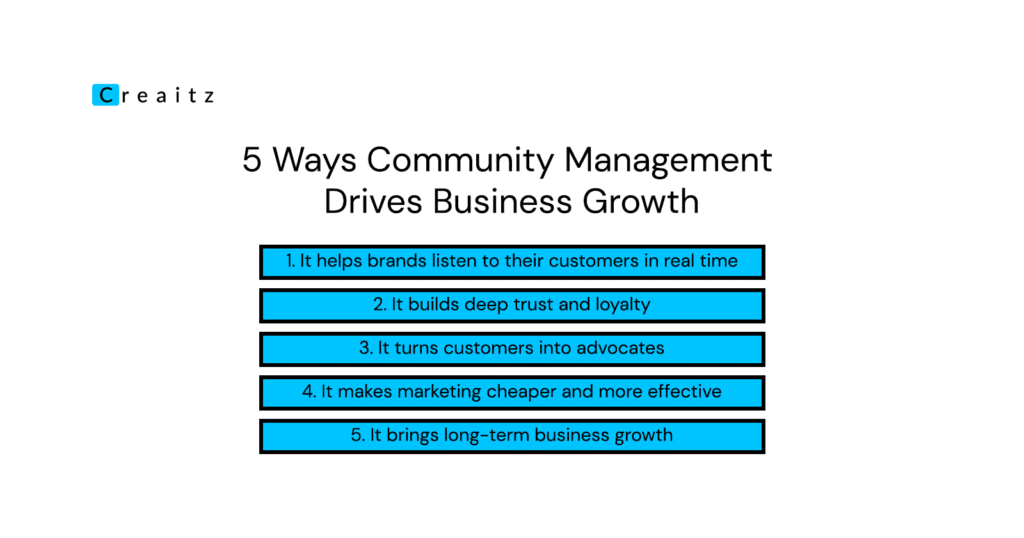
1. It helps brands listen to their customers in real time
Community management allows brands to hear exactly what customers are thinking, their pain points, their ideas, and their suggestions.
As a community manager, you’ll gather this raw and unfiltered feedback and then utilize it to help brands make better, smarter decisions.
Instead of guessing what your audience wants, this way, you’re simply asking and observing.
It’s smarter, faster, and cheaper.
As said earlier, we create blogs, resources, and even free training based on our community feedback, needs, and requests at Creaitz.
And you’ll be pleased to know that it isn’t always directly asking them, it’s filtered from their chats and discussions within the community.
That’s why our activities are always appreciated, because we’re silently observing members’ needs and building resources based on them.
2. It builds deep trust and loyalty
People buy from people they trust.
That trust is built when brands consistently engage, reply, and show up for their audience.
This means making customers feel involved and heard.
A good community manager doesn’t just respond to comments.
They build relationships.
In fact, they know people’s names, and they remember their stories.
When this is done, customers become loyal and they bring their friends along too.
3. It turns customers into advocates
You might have seen the phrase “Happy customers don’t just stay customers, they become marketers.”
When people feel like a brand values them, they talk about it.
They post, they tweet, they recommend.
They do this because they feel like they’re a part of the brand’s growth.
Take, for instance, Apple has a thriving online community that gives its users a platform to share tips and their experiences.
This reduces customer support costs while boosting the visibility of their product. That is the power of a community.
4. It makes marketing cheaper and more effective
Community-led brands spend less on traditional marketing.
And this is because their audience already does half the work for them.
Things like giveaways, community challenges, user-generated content, and member testimonials.
All these aren’t just ads, their conversations. And they’re more powerful.
After our Skills and Sourcing event at Creaitz, we got tons of positive reviews from attendees.
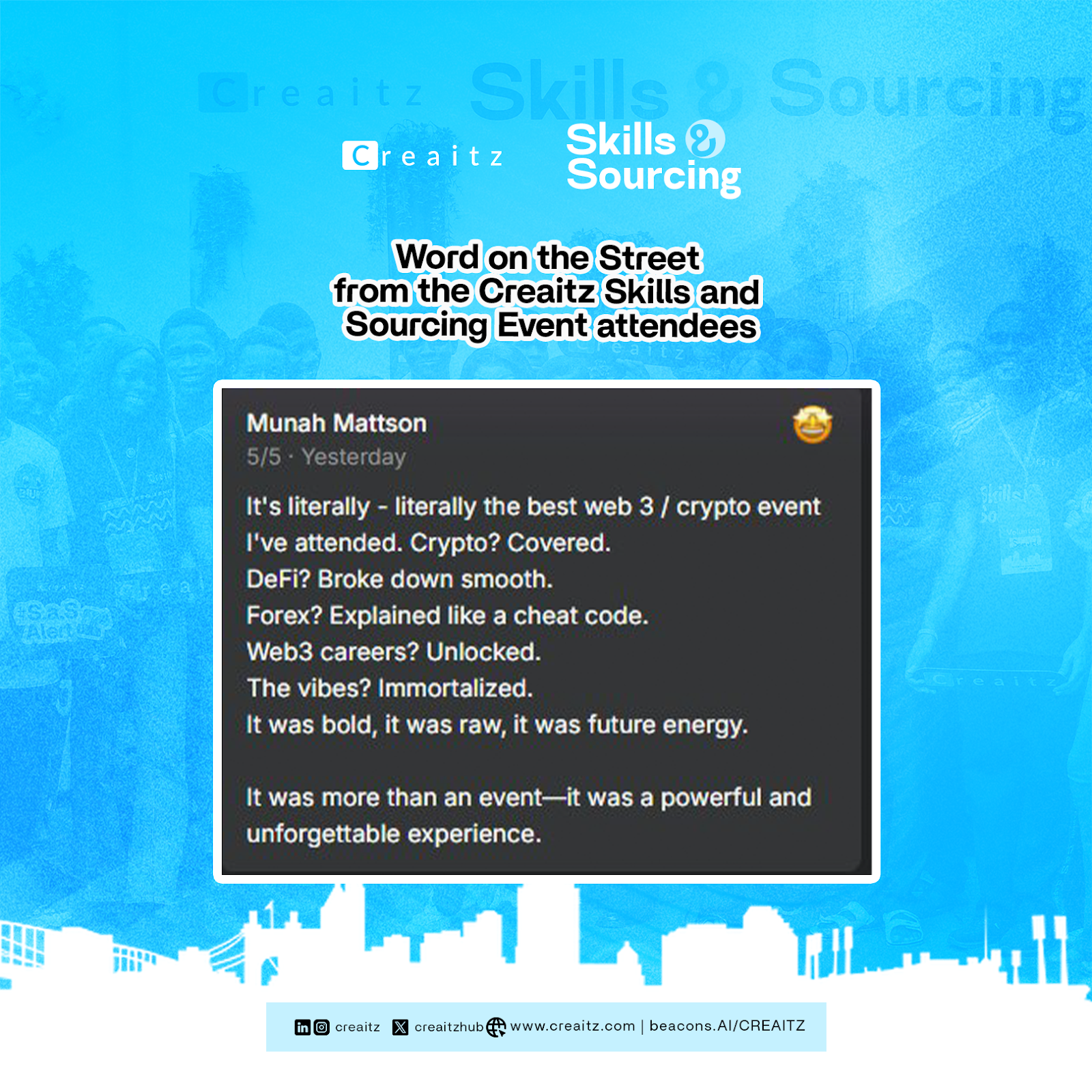
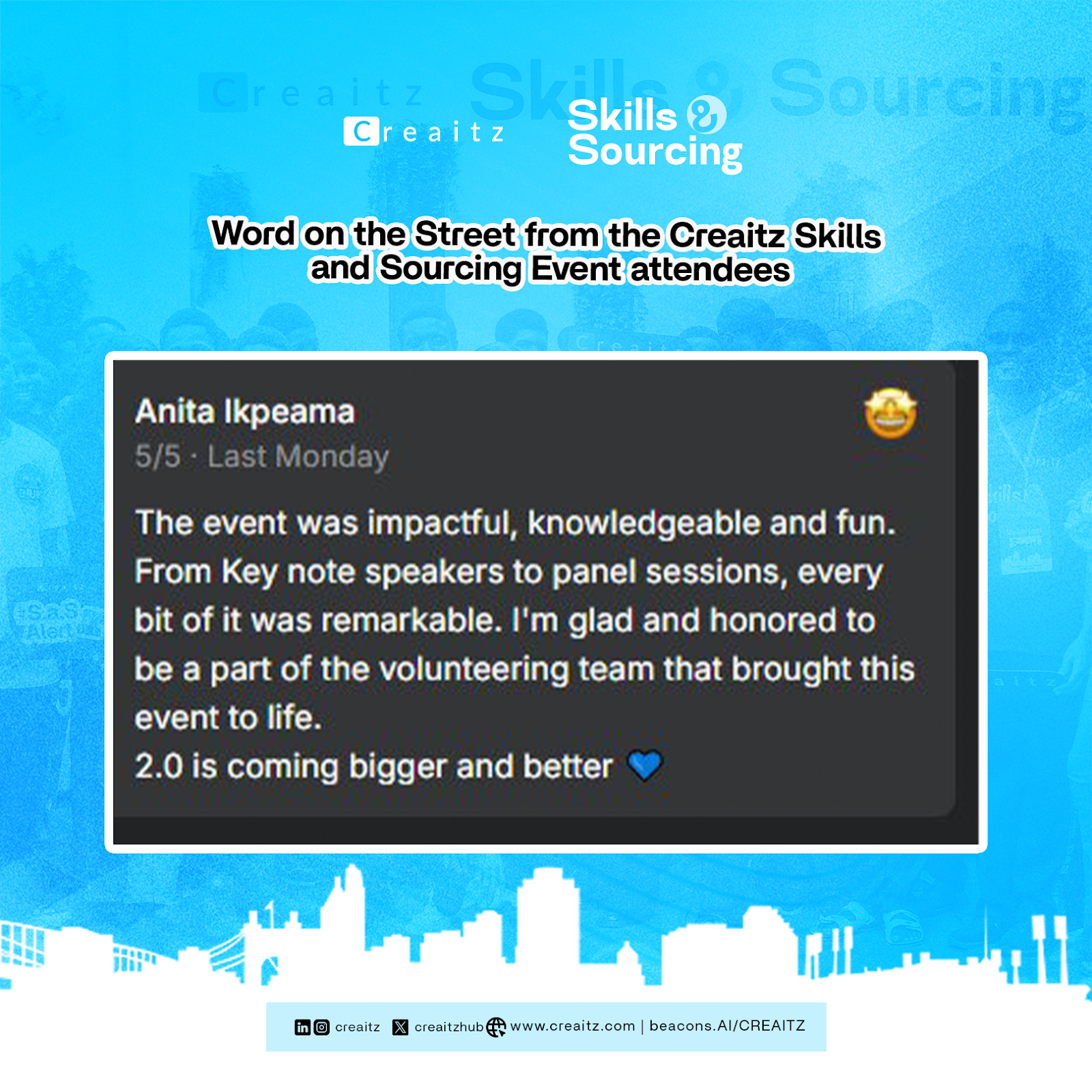
And it didn’t just stop there, many of them went on to post their reviews, testimonials on their socials, earning us more visibility and brand awareness.
Imagine how much we would have to spend paying people to do that for us.
But we have a strong communication of loyal members, who, due to how involved we’ve made them, are now willing to go above and beyond to promote their community.
5. It brings long-term business growth
When customers feel like they belong, they don’t just buy once and leave; they stay.
Community management creates that space where people feel included, respected, and valued.
This builds a kind of loyalty that can’t be bought with ads, discounts, or any digital marketing efforts.
And with time, this translates into consistent sales, strong brand image, and long-term growth.
Types of Community Management
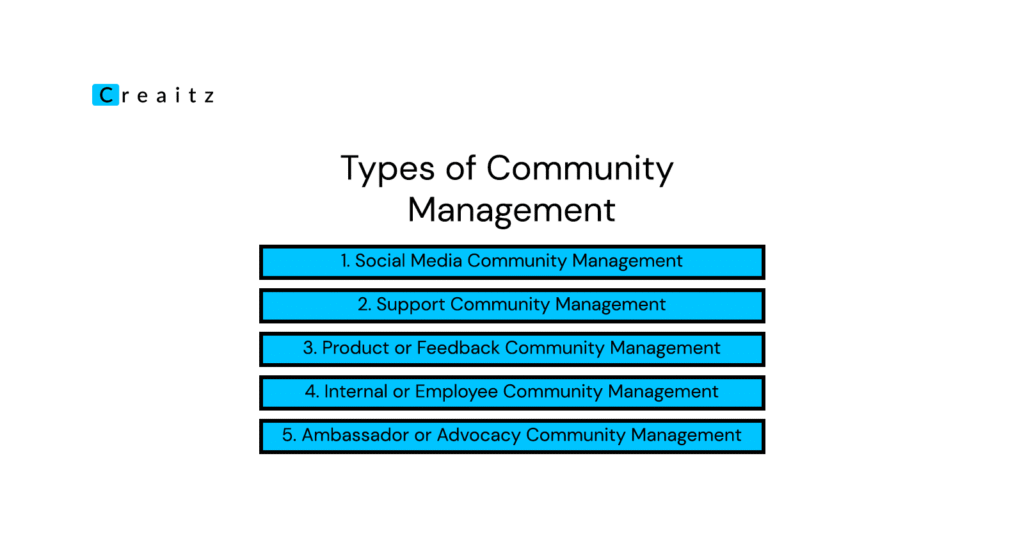
Community management goes way beyond responding to comments or moderating group chats.
There are different types of community management, and each one plays an important role in helping a business grow, connect, and make profits.
1. Social Media Community Management
This is the most common.
It’s probably what comes to your mind when you first hear community management.
As a social media community manager, what you’re doing is managing the brand’s online presence across platforms like Twitter (X), Instagram, LinkedIn, and TikTok.
You’ll promptly give responses to comments, you’ll engage in conversations, and ultimately make people feel seen and valued.
It’s so much more than just replying “Thank you.”
What you’re doing is creating a personality for the brand.
A personality that listens, reacts, and connects emotionally.
According to Sprout Social, brands that respond quickly and consistently to online interactions build 70% more trust with their audience.
Boy, that’s huge!
2. Support Community Management
You must have seen those online forums or Facebook groups where customers help each other solve product issues?
That’s what this is about.
Supporting communities is all about helping customers get answers, fast, and understandably.
The responsibility of being a community manager here is to set up helpful content, moderate conversations, and make sure that people are kind, respectful, and informed.
This reduces customer service costs, keeps people happy, and even turns long-time customers into volunteer helpers.
For example, try asking a random question in the Creaitz community chat page now, you’ll see the enormous responses and answers you’ll get.
Communities like ours are powered by the people, not only moderated by the community managers.
3. Product or Feedback Community Management
This type of community management is behind the scenes, but this doesn’t make them any less good.
As a community manager, what you’ll do here is create a space where customers can give feedback, suggest ideas, and even share how they use the product.
These will help you collect these insights, organize them, and share them with the internal product or strategy teams.
So instead of guessing what to build next or upgrade. Companies can make informed decisions based on what real users want.
At Creaitz, for example, we’ve redesigned entire free training programs just based on casual chats and polls within our community.
That’s what this type of management does: it gives the audience a voice that shapes the future of the brand.
4. Internal or Employee Community Management
Not all communities are external or public.
This type focuses on building a strong internal team culture.
The community manager here helps the staff members to connect, share ideas, and stay aligned with the company’s goals.
It is perfect for remote teams, growing startups, or large organizations where communication can easily break down.
Here, community management helps to build morale, improve collaboration, and trust within the team.
5. Ambassador or Advocacy Community Management
This is where you work with superfans.
The brand already has people who love it; your job as a community manager here is to give them a home, recognize their efforts, and empower them to spread the word.
You’ll manage things like ambassador programs, influencer partnerships, and even affiliate communities.
You see how Nike or Canva works with creators and advocates around the world, that’s this type of community management.
It’s all about turning loyal users into proud, active brand evangelists.
How to Start Your Community Management Career
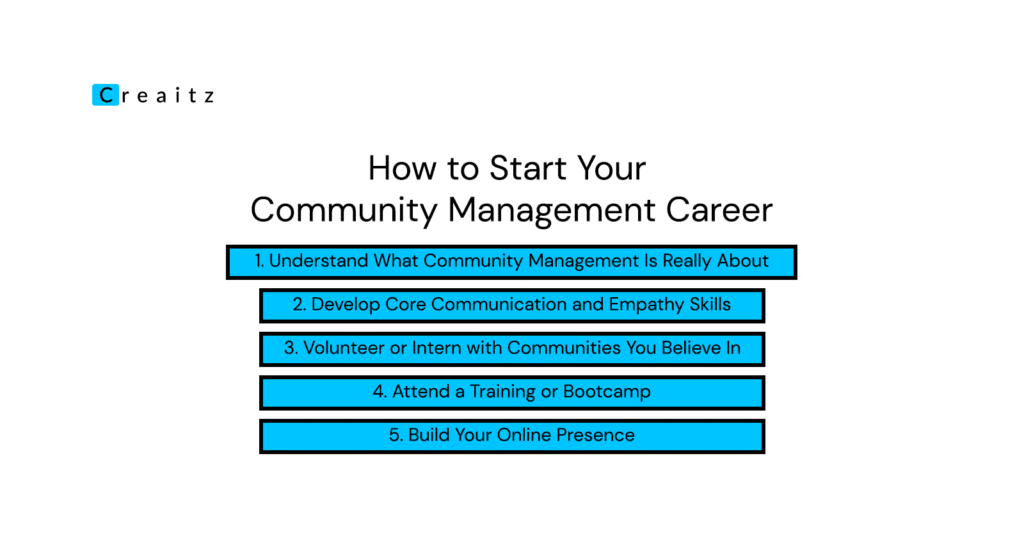
Starting a career in community management shouldn’t be as complicated.
In fact, community management is one of the most exciting and people-focused niches in the digital world today.
And as more companies start to understand and prioritize community management, this means more job opportunities for experts.
Let’s show you how to get started and land high-paying community manager jobs in 5 simple steps.
1. Understand What Community Management Is Really About
Before jumping in, you need to have a solid grasp of community management.
It’s a strategic job responsibility.
It’s about listening, creating belonging, and helping people feel connected to a brand.
So, start by reading blogs, watching valuable interviews, and exploring what brands like Duolingo, Notion, or Nike are doing with their online communities.
These real-world examples will give you a better insight into what the job truly requires.
2. Develop Core Communication and Empathy Skills
Community management is people-first.
It is non-contested.
The most successful community managers aren’t necessarily the most technical; they’re the best communicators.
They know how to listen, resolve conflicts, and speak in ways that resonate with different groups of people.
So, the first thing you want to do is to pay attention to how you talk, write, and respond.
Whether it’s in a WhatsApp group, a Slack channel, or even a comment section.
Start by honing your skills with every conversation you make.
3. Volunteer or Intern with Communities You Believe In
One of the fastest ways to learn is to take on volunteer job roles.
There are many ways volunteering can help you get a job.
You can offer to help moderate a Facebook group you love, assist with a Discord server, or volunteer with a non-profit that runs a digital community.
Of course, these might not be full community manager jobs. In fact, it might not be a salaried role.
But volunteering gives you real and practical experience to include in your resume or portfolio.
You can check out this blog we wrote on how to create a CV that will land you jobs, even with absolutely no prior job experience.
And that’s not all, the feedback and confidence you will gain from volunteering are priceless.
4. Attend a Training or Bootcamp
The good thing is, Community management isn’t something most people go to school for.
It’s one of those careers you grow into by learning, practicing, and evolving.
However, while you may not need a degree, having the right knowledge can open doors faster than you think.
This is where training and boot camps come in.
They give you access to real-world skills.
You’ll learn how to build and manage online communities, how to create content that keeps people talking, how you can handle tough feedback, track performance, and several other things.
If you’re curious about where to start or find one, we’ve got you.
Register here for our upcoming free Community Management training.
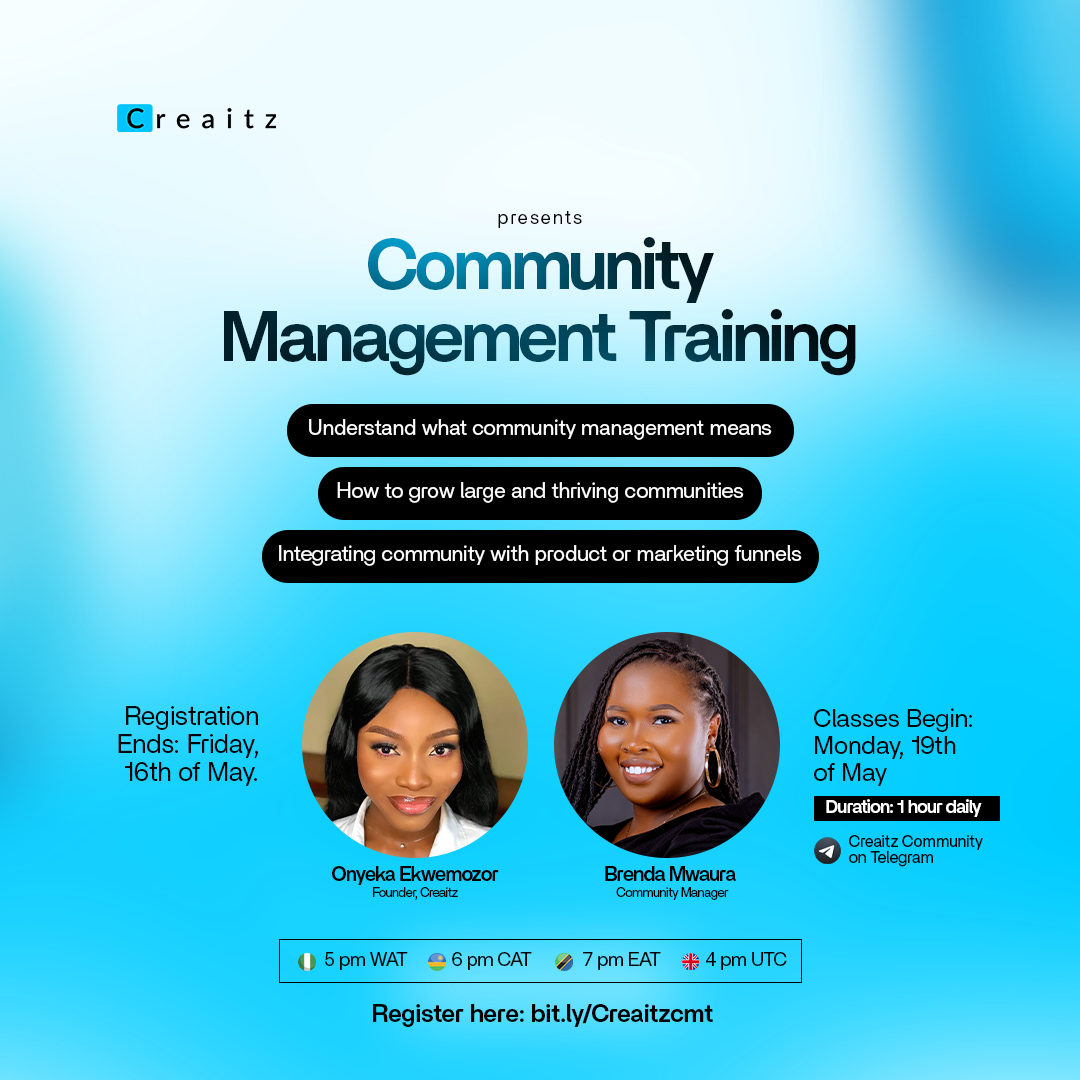
It’s beginner-friendly, completely free, and designed to help you excel in your career as a community manager.
5. Build Your Online Presence
One of the best ways to prove your skills is by showing them.
But how do you do this?
Start a small online community around something you love. It could be books, movies, tech, anything.
You can also start sharing tips to help communities on your Twitter, LinkedIn, or blog.
This tells potential employers that you’re not just learning, you’re doing.
So that when they eventually come across your profile (and they will), they’ll see someone who’s already thinking and operating like a community manager.
What Tools Do You Need to Excel at Community Management?
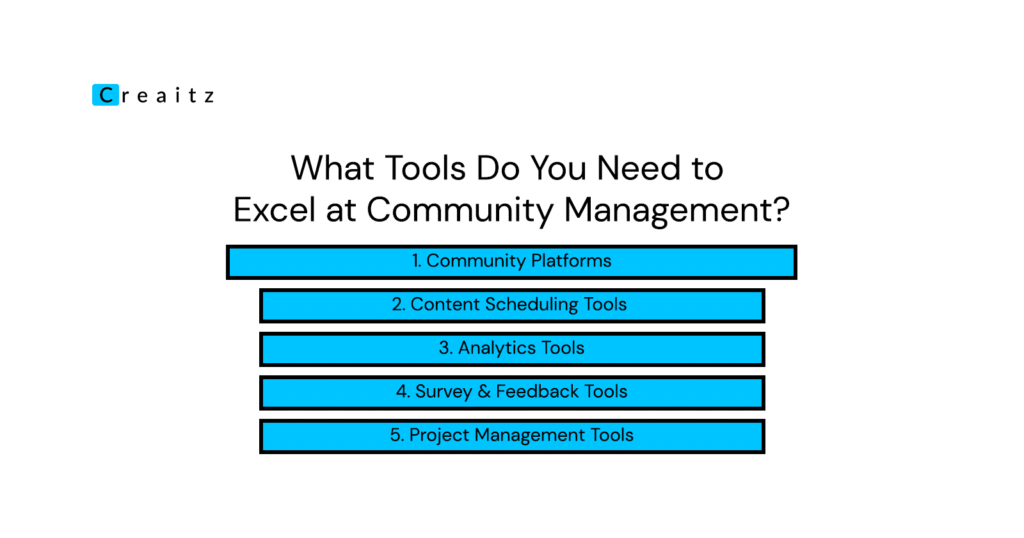
Since we’re answering the question, “What is community management really about?”, it’s necessary that we explain the tools you’ll need in community manager jobs.
Here are five tools that will make your life way easier as a community manager:
1. Community Platforms
These consist of WhatsApp, Telegram, Discord, Slack, and Meta groups.
They are platforms where your community lives.
It could be Slack for a professional audience, Telegram or Discord for a younger, tech-savvy crowd, or even Facebook Groups for a wider range of users.
This platform is where you’ll build engagement.
You’ll use these platforms to host discussions, run events, gather feedback, and grow your audience.
2. Content Scheduling Tools
Proficiency in content planning is a core attribute for community managers.
You will be responsible for sharing updates, announcements, events, or responses, and you need a scheduling tool to help you stay consistent.
With tools like Buffer or Hootsuite, you’ll be able to plan posts ahead of time, keep track of your calendar, and maintain an active presence without burning yourself out in the process.
You can also leverage bots on Telegram or Discord to reduce routine tasks.
3. Analytics Tools
If you can’t measure your strategy, then you can’t grow it.
Analytics tools help you to understand what your community is engaging with, what posts are doing well, and where and why people are dropping off.
Some platforms have native analytics set up. But you can try third party apps for more data.
Another benefit of this is that it helps you to justify your decisions to management or the business owner by showing the value of your efforts in quantifiable numbers.
4. Survey & Feedback Tools
To create those deep emotional connections we discussed earlier, you need to know what your community wants.
Surveys are an underrated strategy to ask questions, gather suggestions, and let your members know that they’re heard.
As a good community manager, you need to use inbuilt features like Telegram or WhatsApp polls or external tools like Typeform or Google Forms to do this consistently.
5. Project Management Tools
When you’re managing an active community, especially as part of a team, staying organized is an important asset.
Tools like Trello or Notion can help you keep track of ideas, plan content, delegate tasks, and even record feedback, all in a single place.
They make it easier to move from idea to execution without getting overwhelmed.
How Much Do Community Managers Earn?
According to Glassdoor, an average community manager earns around $70,000 in the United States.
However, this can go much higher depending on the company, location, and level of experience.
Senior community managers, especially those who work with global brands or tech companies, earn between $90,000 to $120,000 per year.
Even for freelance roles or part-time contracts, community managers are being paid well for the value they bring.
If you’re wondering whether it’s a career path worth taking, well, the numbers speak for themselves.
In Conclusion
The future of business is shifting, it’s no longer the usual one-size-fits-all marketing. It’s now more about conversations, belonging, and real human connection.
That’s the power of community management. And that’s where you come in.
You don’t need to have it all figured out yet. You just need to start.
At Creaitz, we’re building the largest digital skills community in Africa, full of learners, mentors, creators, and people just like you who are ready to make a real impact.
Join the Creaitz community today and let’s help you grow, learn, and connect with real opportunities in community management and beyond.
Related Content You Might Enjoy
